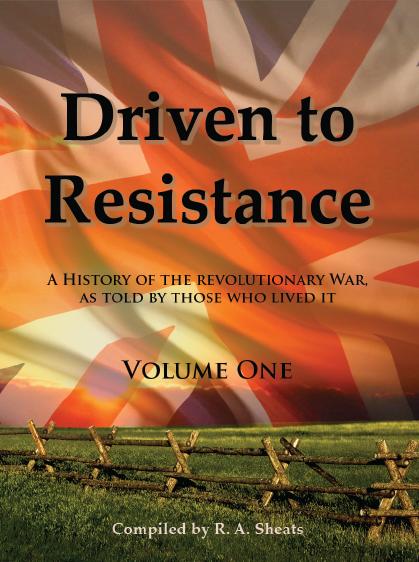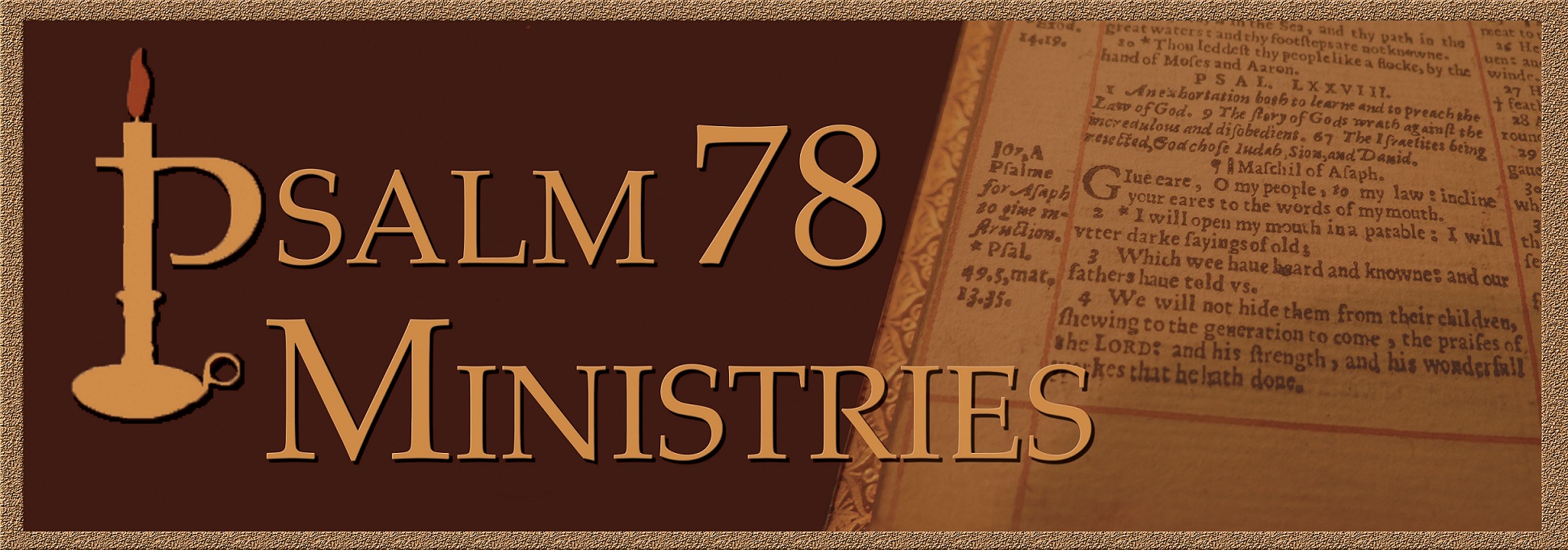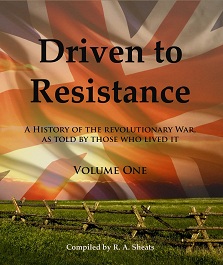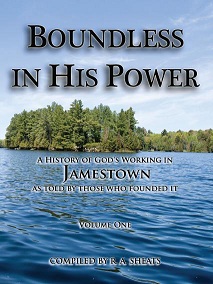FURTHER READING
Whether the topic is the Revolutionary War, the settling of Jamestown, the Reformation in Geneva, or the history of Scottish missionary John G. Paton, Psalm 78 Ministries desires to help the contemporary reader find easily-accessible original documents and reliable secondary sources for the histories in question. In each of our books a section will be found entitled FURTHER READING, listing materials we were simply unable to fit inside the actual volumes themselves. These original materials (and several secondary sources) are provided here free of charge.
Materials are divided by book and chapter. Simply click on a volume title or its corresponding chapters to see the further reading available. If you experience any difficulty viewing or downloading the materials, please contact us.
DRIVEN TO RESISTANCE
Chapter
1,
2,
3,
4,
5,
6,
7,
8,
9,
10,
11,
12,
13,
14,
15,
16,
17,
18,
19
BOUNDLESS IN HIS POWER
Chapter
1,
2,
3,
4,
5,
6,
7,
8,
9,
10,
11,
12,
13,
14
REFORMATION RHYMES
Four Volume Set
Volume One: Martin Luther: They That Wait Upon the Lord
Volume Two: William Farel: God Shall Give the Increase
Volume Three: Pierre Viret: God Meant It unto Good
Volume Four: John Calvin: I Will Rejoice in the LORD
ASK OF ME: JOHN G. PATON,
MISSIONARY TO THE SOUTH SEA CANNIBALS
A History in Rhyme

DRIVEN TO RESISTANCE
VOLUME ONE
CHAPTER ONE:
The Stamp Act of 1765
Primary Sources:
— John Adams’ description of civil government. (See appendix of Driven to Resistance, pages 209-210.)
— For a history of Washington’s early life preceding the Stamp Act, see Jared Sparks’ biography, as well as Washington’s papers and correspondence during this time:
Jared Sparks, The Writings of George Washington, Volume One
Jared Sparks, The Writings of George Washington, Volume Two
— Pages 1-144 in John Adams’ diary and autobiography:
Charles Francis Adams, The Works of John Adams, Volume II
Secondary Sources:
— On the state of the colonies prior to the Revolution and the introduction of the Stamp Act, see the first two chapters of:
David Ramsay, The History of the American Revolution
— On Patrick Henry, see:
William Wirt, The Life of Patrick Henry
CHAPTER TWO:
What is to be Done?
Primary Sources:
Pages 145-194 in John Adams’ diary and autobiography:
Charles Francis Adams, The Works of John Adams, Volume II
— See also Washington’s correspondence during this time:
Jared Sparks, The Writings of George Washington, Volume Two
CHAPTER THREE:
The Repeal
Primary Sources:
— Washington’s letter to Capel Hanbury, July 25, 1767, pages 344-345 in:
Jared Sparks, The Writings of George Washington, Volume Two
— Pages 195-212 in John Adams’ diary and autobiography:
Charles Francis Adams, The Works of John Adams, Volume II
— Full text of Reverend Charles Chauncy’s sermon, found on pages 105-146 of:
John Wingate Thornton, ed., The Pulpit of the American Revolution
— The Puritans on Thankfulness, available from Chapel Library:
Free Grace Broadcaster #190, Thankfulness.
CHAPTER FOUR:
The Revenue Act
Primary Sources:
Pages 213-228 in John Adams’ diary and autobiography:
Charles Francis Adams, The Works of John Adams, Volume II
CHAPTER FIVE:
The Boston ‘Massacre’
Primary Sources:
— The full text of the trial of the British soldiers involved in the March 5th affair has been compiled by:
Frederic Kidder, History of the Boston Massacre, consisting of the Narrative of the Town, the Trial of the Soldiers, and a Historical Introduction
— Pages 229-322 in John Adams’ diary and autobiography:
Charles Francis Adams, The Works of John Adams, Volume II
CHAPTER SIX:
Boston and the Tea
Primary Sources:
— Pages 1-13 of the letters of John Andrews, resident of Boston:
John Andrews, Letters of John Andrews, Esq., of Boston
— Pages 323-332 in John Adams’ diary and autobiography:
Charles Francis Adams, The Works of John Adams, Volume II
CHAPTER SEVEN:
Response to the Destruction of the Tea
Primary Sources:
— Chapter three of:
David Ramsay, The History of the American Revolution
CHAPTER EIGHT:
To Arms?
Primary Sources:
— Pages 332ff in John Adams’ diary and autobiography:
Charles Francis Adams, The Works of John Adams, Volume II
— “George Washington on Further Petitions,” in appendix to
Driven to Resistance, pages 213-214.
CHAPTER NINE:
Closure of the Boston Port
Primary Sources:
— Full text of the Fairfax County Resolves
— Full text of the Suffolk Resolves
CHAPTER TEN:
Distresses in Boston
Primary Sources:
— John Adams’ letter to his wife regarding the meeting of the Continental Congress, in appendix to Driven to Resistance, pages 215-216.
— Letters of John Andrews during this time:
John Andrews, Letters of John Andrews, Esq., of Boston
CHAPTER ELEVEN:
Heightening Troubles
Primary Sources:
— Letters of John Andrews during this time:
John Andrews, Letters of John Andrews, Esq., of Boston
— Washington’s letters from July-October, 1774, pages 388-402 in:
Jared Sparks, The Writings of George Washington, Volume Two
— John Adams’ diary and autobiography during this time:
Charles Francis Adams, The Works of John Adams, Volume II
CHAPTER TWELVE:
The Dawning of ’75
Primary Sources:
— History and collection of first-hand accounts respecting Colonel Leslie and the Salem bridge affair:
Charles M. Endicott, Account of Leslie’s Retreat at the North Bridge, on Sunday
CHAPTER THIRTEEN:
Lexington and Concord
Primary Sources:
— Proceedings of Parliament regarding the American Colonies, pages 74ff of:
Cobbett, Parliamentary History of England from the Earliest Period to the Year 1803, Volume XVIII
— First-hand accounts of the battles of Lexington and Concord, pages 365-372 of:
— Washington’s letter (regarding the battles of Lexington and Concord) to George William Fairfax, May 31, 1774, pages 406-407 in:
Jared Sparks, The Writings of George Washington, Volume Two
CHAPTER FOURTEEN:
Liberty or Death!
Secondary Sources:
— On Patrick Henry, see:
William Wirt, The Life of Patrick Henry
CHAPTER FIFTEEN:
Congress Meets in Philadelphia
Primary Sources:
— “Declaration and Resolves of the First Continental Congress,” in appendix to Driven to Resistance, pages 217-218.
— General Washington’s correspondence regarding his appointment as Commander-in-Chief, pages 1-9 in:
Jared Sparks, The Writings of George Washington, Volume Three
— John Adams’ diary and autobiography during this time, pages 405ff of:
Charles Francis Adams, The Works of John Adams, Volume II
CHAPTER SIXTEEN:
Boston Besieged
Primary Sources:
“Proclamation by Governor Gage in Response to Lexington and Concord,” in appendix to Driven to Resistance, pages 219-222.
— Letters of John Andrews during this time:
John Andrews, Letters of John Andrews, Esq., of Boston
CHAPTER SEVENTEEN:
Bunker Hill
Primary Sources:
— “Order for a Public Fast by the Massachusetts Congress,” in appendix to Driven to Resistance, pages 223-224.
— “General Burgoyne on the Battle of Bunker Hill,” in appendix to Driven to Resistance, pages 225-226.
— First-hand accounts of the battle of Bunker Hill, pages 372ff of:
CHAPTER EIGHTEEN:
Besieging Boston
Primary Sources:
— General Washington’s correspondence regarding his arrival at the continental army outside Boston, pages 10ff in:
Jared Sparks, The Writings of George Washington, Volume Three
— John Adams on Bunker Hill and his subsequent visit to Headquarters, pages 418ff of:
Charles Francis Adams, The Works of John Adams, Volume II
CHAPTER NINETEEN:
Britain’s Response
No Further Reading currently available for this chapter.
BOUNDLESS IN HIS POWER
VOLUME ONE
CHAPTER ONE:
To Virginia
Primary Sources:
— Full text of the Virginia Company’s charter of April 6, 1606.
— Full text of the Virginia Company’s Articles, Instructions, and Orders to their colonists.
— Full text of Richard Hakluyt’s Discourse Concerning Western Planting.
Secondary Sources:
— “How Shall They Call on Him? Richard Hakluyt and the American Dream,” in Cast Thy Bread Upon the Waters
CHAPTER TWO:
The New World
Secondary Sources:
“Thy Footsteps are not Known: Reverend Hunt and the Voyage to Virginia,” in Cast Thy Bread Upon the Waters
CHAPTER THREE: Meeting the Savages
Primary Sources:
— Henry Spelman’s description of the Virginia Indians, in appendix to Boundless in His Power, pages 145-147.
— William White’s description of the Virginia savages
CHAPTER FOUR: Newport’s Return to England
Primary Sources:
— Council in Virginia to the Council in England
CHAPTER FIVE: First Troubles
Primary Sources:
— Full account of George Percy’s Discourse
Secondary Sources:
— “They That Serve Graven Images: A Brush with the Savages,” in Cast Thy Bread Upon the Waters
CHAPTER SIX: Up the Chickahominy
Primary Sources:
— Correspondence between Don Pedro de Zuñiga and Philip III, king of Spain
Secondary Sources:
— “Lord, What is Man? Captain Smith’s Exploration of the Chickahominy,” and “He Turneth it Whithersoever He Will: Of Compasses and Kings.”
CHAPTER SEVEN:
Arrival of the First Supply
Primary Sources:
— Letter of Francis Perkins, colonist who arrived with the First Supply from England
Secondary Sources:
— “I Have Seen the Wicked in Great Power: Return and Reception at Jamestown,” and “Remember His Marvelous Works: What Happened that Evening,” in Cast Thy Bread Upon the Waters
CHAPTER EIGHT:
Fire and Gold
No Further Reading currently available for this chapter.
CHAPTER NINE:
Savages and Stingrays
No Further Reading currently available for this chapter.
CHAPTER TEN:
Meeting the Rappahannocks
Primary Sources:
— Full account of the second exploration trip up the bay, included in Smith’s Generall Historie, pages 124-137.
CHAPTER ELEVEN:
A New President
Primary Sources:
CHAPTER TWELVE:
Back to Powhatan
Secondary Sources:
“Thou Hatest All Workers of Iniquity: A Visit to Powhatan,” and “Before the Judgment Seat of Christ: A Tale of Treachery,” in Cast Thy Bread Upon the Waters
CHAPTER THIRTEEN:
Skirmish with the Savages
No Further Reading currently available for this chapter.
CHAPTER FOURTEEN:
Tragedy and Triumph
No Further Reading currently available for this chapter.
MARTIN LUTHER:
THEY THAT WAIT
UPON THE LORD
Martin Luther and the Diet of Worms
For a history of the life and times of Martin Luther, see:
Jean Henri Merle D'Aubigne, History of the Reformation of the Sixteenth Century, Volume Two.
J. A. Wylie, The History of Protestantism, Volume I.
J. A. Wylie, The History of Protestantism, Volume II.
WILLIAM FAREL:
GOD SHALL GIVE
THE INCREASE
William Farel and the Reformation in Switzerland
For a history of the life and times of William Farel, see:
Jean Henri Merle D'Aubigne, History of the Reformation of the Sixteenth Century, Volume Two.
J. A. Wylie, The History of Protestantism, Volume I.
J. A. Wylie, The History of Protestantism, Volume II.
PIERRE VIRET:
GOD MEANT IT
UNTO GOOD
Pierre Viret and the Reformation in Switzerland and France
For a history of the life and times of Pierre Viret, see:
Jean Henri Merle D'Aubigne, History of the Reformation of the Sixteenth Century, Volume Two.
J. A. Wylie, The History of Protestantism, Volume I.
J. A. Wylie, The History of Protestantism, Volume II.
For a full biography of Pierre Viret, see:
R. A. Sheats, Pierre Viret: the Angel of the Reformation,
JOHN CALVIN:
I WILL REJOICE
IN THE LORD
John Calvin and the Reformation in Geneva
For a history of the life and times of John Calvin, see:
For an article detailing Viret's work in Geneva and Calvin's return to that city, compiled primarily from the letters of Calvin and his contemporaries, see:
R. A. Sheats, Calvin and Viret, Brethren in Unity.
Calvin's letters dating from this period have been collected and translated by:
Jules Bonnet, Letters of John Calvin, Volume I: 1538-1541.
ASK OF ME: JOHN G. PATON,
MISSIONARY TO THE
SOUTH SEA CANNIBALS
A History in Rhyme
John G. Paton’s autobiography:
John G. Paton, John G. Paton, Missionary to the New Hebrides, an Autobiography.
A history of John Paton, written especially for younger readers, adapted from Paton’s autobiography, is available here:
John Paton for Young Folks: Missionary Life among South Sea Cannibals.
Letters and papers of John Paton’s second wife:
Maggie Whitecross Paton, Letters and Sketches from the New Hebrides.


